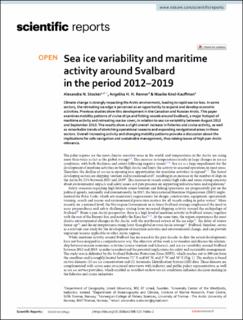Sea ice variability and maritime activity around Svalbard in the period 2012–2019
| dc.contributor.author | Stocker, Alexandra N. | |
| dc.contributor.author | Renner, Angelika | |
| dc.contributor.author | Knol-Kauffman, Maaike | |
| dc.date.accessioned | 2020-10-15T11:46:16Z | |
| dc.date.available | 2020-10-15T11:46:16Z | |
| dc.date.created | 2020-10-14T10:46:19Z | |
| dc.date.issued | 2020 | |
| dc.identifier.citation | Scientific Reports. 2020, 10 1-12. | en_US |
| dc.identifier.issn | 2045-2322 | |
| dc.identifier.uri | https://hdl.handle.net/11250/2683070 | |
| dc.description.abstract | Climate change is strongly impacting the Arctic environment, leading to rapid sea ice loss. In some sectors, the retreating ice edge is perceived as an opportunity to expand and develop economic activities. Previous studies show this development in the Canadian and Russian Arctic. This paper examines mobility patterns of cruise ships and fishing vessels around Svalbard, a major hotspot of maritime activity and retreating sea ice cover, in relation to sea ice variability between August 2012 and September 2019. The results show a slight overall increase in fisheries and cruise activity, as well as remarkable trends of stretching operational seasons and expanding navigational areas in these sectors. Overall increasing activity and changing mobility patterns provoke a discussion about the implications for safe navigation and sustainable management, thus raising issues of high pan-Arctic relevance. | en_US |
| dc.language.iso | eng | en_US |
| dc.title | Sea ice variability and maritime activity around Svalbard in the period 2012–2019 | en_US |
| dc.type | Peer reviewed | en_US |
| dc.type | Journal article | en_US |
| dc.description.version | publishedVersion | en_US |
| dc.source.pagenumber | 1-12 | en_US |
| dc.source.volume | 10 | en_US |
| dc.source.journal | Scientific Reports | en_US |
| dc.identifier.doi | 10.1038/s41598-020-74064-2 | |
| dc.identifier.cristin | 1839438 | |
| cristin.ispublished | true | |
| cristin.fulltext | original | |
| cristin.qualitycode | 1 |
Tilhørende fil(er)
Denne innførselen finnes i følgende samling(er)
-
Articles [3012]
-
Publikasjoner fra CRIStin [3070]
